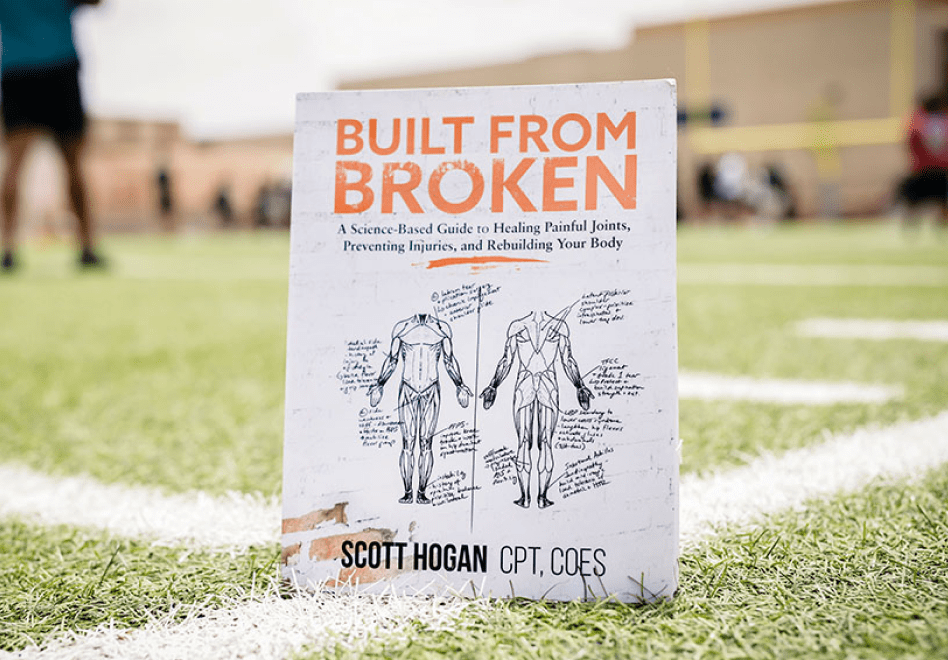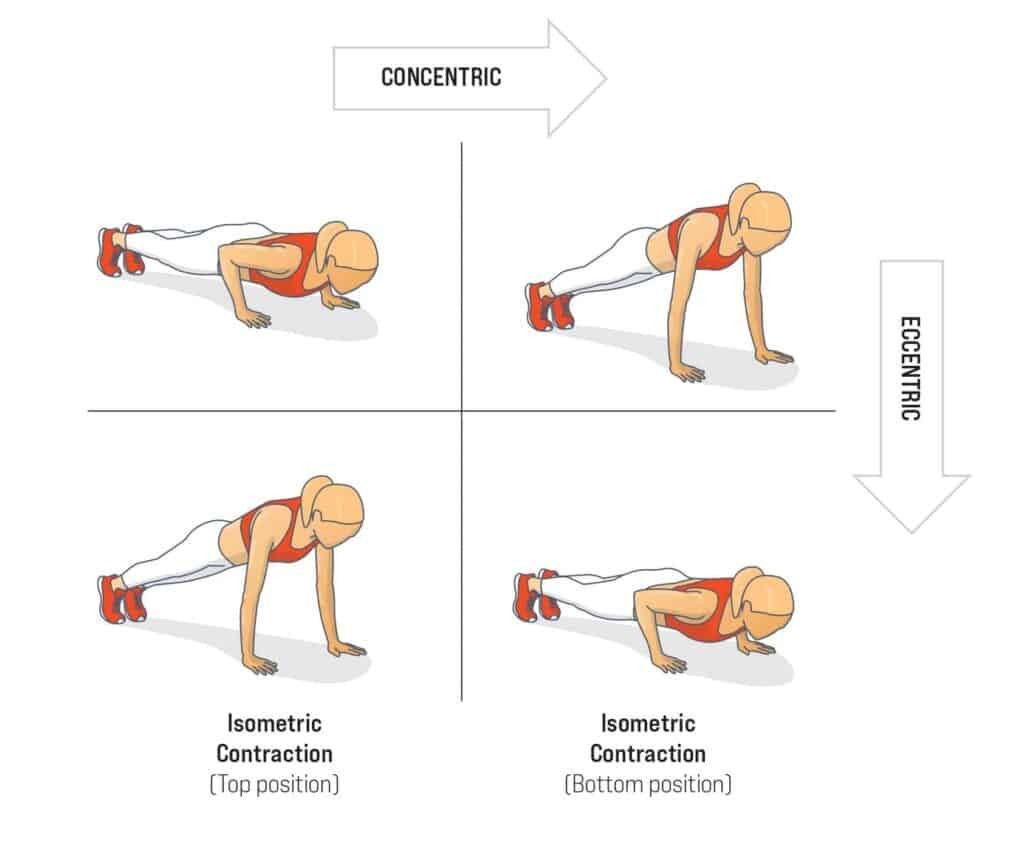
Be built (to last).
The right supplements can help you recover naturally and build a resilient body.

Supplement Quiz
Take this short quiz to discover the perfect supplements for your needs and goals.
About SaltWrap

Built from Broken
Get the best-selling book from SaltWrap founder, Scott Hogan, and start rebuilding today.
Eccentric Training: What It Is and How to Use It for Tendonitis Recovery
by Scott Hogan, ACE-CPT, COES
Eccentric training is the most underutilized, underrated corrective exercise technique. When implemented properly, it can help you build more muscle, improve flexibility, and fortify your connective tissue against injury.
This article provides an overview of how eccentric training works, the benefits, and how to safely implement it into your training routine.
What is eccentric training?
Eccentric training a form of resistance training that emphasizes the lowering phase of an exercise to challenge the muscles’ ability to elongate, build strength and muscle mass, and optimize collagen formations within connective tissue.
It creates more muscular force than any other exercise type. It also produces the largest increases in muscle fiber length, making it a useful flexibility training method. When implemented correctly, it’s a safe and effective resistance training technique.
How does eccentric training work?
In order to understand how eccentric training works, it’s helpful to understand the various types of muscle contractions. There are three primary types of muscle contractions. Each affects skeletal muscle and connective tissues differently:
- Eccentric contraction: A contraction where the muscle lengthens under load or tension. Think of this as the lowering or lengthening phase of an exercise. For example, the downward phase of a push-up forces your chest muscles to lengthen and simultaneously contract to control the lowering movement. By definition, eccentric contractions occur when the opposing force is greater than the muscular contraction force.
- Concentric contraction: Any muscle contraction where the muscle shortens during the movement. Think of this as the lifting phase of an exercise. When performing a push-up, your chest muscles contract as you push yourself away from the ground.
-
Isometric contraction: Eccentric and concentric contractions fall into a broader category called isotonic contractions—where muscle length is changed by force applied. An isometric contraction occurs when force is generated without the muscle length changing. A classic example is pushing against a wall.
You may not move the wall, but you can still exert a massive amount of force against it. Isometric contractions can occur at any point throughout a movement’s range of motion.
If you hold the bottom position of a push-up with your chest off the ground, that is an isometric contraction that challenges your chest muscles in a fully lengthened position.
Holding the top position of a push-up with your arms extended will create an isometric contraction in your shoulders and triceps as they tense up to keep your body from falling to the ground.
++
In the real world and in the weight room, these various types of contractions are usually combined into natural movement sequences. However, by focusing only on the eccentric phase of movement, or at least placing additional focus on the eccentric phase, you are able to more effectively stimulate muscle growth.
This is because the eccentric movement phase recruits fast-twitch muscle fibers more effectively and places more stress on the muscles than the concentric phase.
Additionally, eccentric training promotes healing responses within tendons that help rebuild and protect connective tissue.
Why eccentric training is important in your exercise program
There are many reasons to incorporate eccentric exercise in your exercise program, but the most research-backed, practical reason is to prevent tendonitis, tendinopathy, and other connective tissue injuries.
Most exercise regimens focus on fast-paced movements that emphasize the concentric, or lifting, phase of the movement. Over time, this creates an imbalance between the development of your muscles and the resiliency of underlying connective tissues.
By adding eccentric training to your exercise routine, you can effectively fortify your tendons and joint systems against overuse injuries. This is evidenced by the fact that eccentric exercise is the most common therapeutic exercise regimen for treatment of tendinopathy (tendon degeneration).
What are the benefits of eccentric training?
Despite common assumptions about eccentric training being an advanced training method reserved only for bodybuilders and athletes, decades of research show it helps prevent injuries, improves mobility, and supports overall health and wellness in virtually every population. Here are a few of the most cited benefits of eccentric training:
- Strength: Compared to concentric-only training, eccentric training more effectively promotes increased motor unit recruitment and strength adaptations.
- Muscle growth: A meta-analysis published in the British Journal of Sports Medicine determined that eccentric exercise is superior to concentric exercise in stimulating muscle growth.
- Flexibility: Eccentric training has the added benefit of improving muscle length and range of motion. Unlike stretching, eccentric training under load shifts more emphasis to lengthening the muscle rather than simply pulling against connective tissue.
- Metabolic function: Studies of overweight subjects have shown that eccentric training is an efficient method of reducing fat mass, improving blood lipid profiles, and supporting blood sugar health.
- Injury risk: Eccentric training has been shown to reduce soccer players’ hamstring injury rates by up to 70% and prevent degenerative tendinopathy.
- Injury rehabilitation: Eccentric training is one of the first protocols introduced in physical therapy to help rebuild and strengthen soft tissues after injury.
How to use eccentric training to recover from tendonitis and tendinopathy
Unlike NSAIDs, rest, stretching and many other common tendinopathy treatments, only eccentric training and slow-tempo exercise helps rebuild damaged tendon cells in a way that allows for full recovery from tendon overuse injuries.
A study of patients with patellar tendinopathy (degeneration of the tendon located just below the kneecap) demonstrated that eccentric training improved short-term and long-term measures of pain, strength, and collagen turnover. In the same study, patients who used corticosteroid injections to manage inflammation and pain showed short-term improvements in pain levels but poor long-term tendon health.
Another study of patients with Achilles’ tendinopathy showed that 12 weeks of slow, eccentric-focused training increased collagen synthesis in injured tissues. As the researchers pointed out, this could indicate a relationship between necessary collagen turnover and tendon injury recovery.
See Related: The Difference Between Tendinitis and Tendinopathy in Injury Recovery Guide
(Collagen formation illustration) Eccentric training helps realign and strengthen collagen formation patterns within tendons.
How to safely incorporate eccentric training into your exercise routine
Here are four ways to incorporate eccentric training into your exercise routine. For all of the methods referenced below, remember that your muscles and joints need 2-3 days to recover between sessions to prevent accumulated stress:
Four types of eccentric exercise
-
The 2/1 Technique: Lift the weight with two limbs through the concentric phase, then use only one limb during the eccentric phase.
-
The Two-Movement Technique: This is a more advanced technique with a relatively simple underlying principle: use a compound movement (utilizing multiple muscles) to lift the weight, then an isolation movement (focused on one muscle) to lower the weight. A common example is performing a close-grip bench press, followed by a triceps extension during the eccentric phase to emphasize triceps development.
-
The Slow/Superslow Technique: This is the ideal introduction to eccentric training. To utilize the Slow/Superslow Technique, choose a weight you can easily lift for 10-15 repetitions. Lift it using a controlled but swift repetition speed, then exaggerate the eccentric portion of the exercise, taking around 5 full seconds to lower it.
- The Negative (Supramax) Technique: This is an advanced technique that requires assistance from at least one spotter. To perform the supramax technique, the lifter will choose a weight that is close to the maximum amount of weight they can lift through the concentric portion of the movement.
After the lifter slowly lowers the weight through the eccentric portion of the movement, the spotters will assist in lifting the weight back up or complete the concentric portion of the movement without the lifter getting involved. The main idea is to focus the lifter’s efforts on controlling the eccentric phase of the movement without expending energy on the concentric phase.
How to get started with eccentric training
The volume of eccentric training you should perform depends on your fitness level, injury status, and goals. To start, I recommend completing 3-6 sets per week of either the 2/1 Technique or Slow/Superslow Technique. Choose a weight you can easily lift for 10-15 repetitions, then focus on controlling the eccentric phase of the exercise for 5 seconds. It’s not necessary to push your muscles to the brink of failure to benefit from eccentric training.
Conclusion
Eccentric training should be a staple in your exercise routine, whether your goal is to build muscle and strength, improve flexibility, or prevent overuse injuries. Though you will likely experience some muscle soreness after completing an eccentric training session, it’s a relatively safe technique that bolsters overall joint function and total body resilience.
To learn more about how to program eccentric training into your exercise routine, check out my book, Built from Broken.
In it, I lay out a complete training program with exercise demonstrations, set and repetition schemes, and periodization techniques that ensure you make consistent progress toward your fitness goals without causing joint degeneration and overuse injuries.
Founder: Scott Hogan

I created SaltWrap to bring together the most practical ideas in therapeutic sports nutrition, corrective exercise, and functional fitness — with the goal of keeping you (and myself) strong, mobile, and built to last.
I've worked as an A.C.E. Certified Personal Trainer, Orthopedic Exercise Specialist, and nutritional supplement formulator.
But more importantly — I've spent most of my life battling injuries, joint pain, and just being plain beat up. So I know what it's like to struggle toward fitness goals.
SaltWrap is here to push you through injuries, setbacks and perceived physical limitations. To a place beyond what you think you're capable of. Sign up here to stay in the loop.
Learn more about my best-selling injury prevention and recovery book, Built from Broken.









